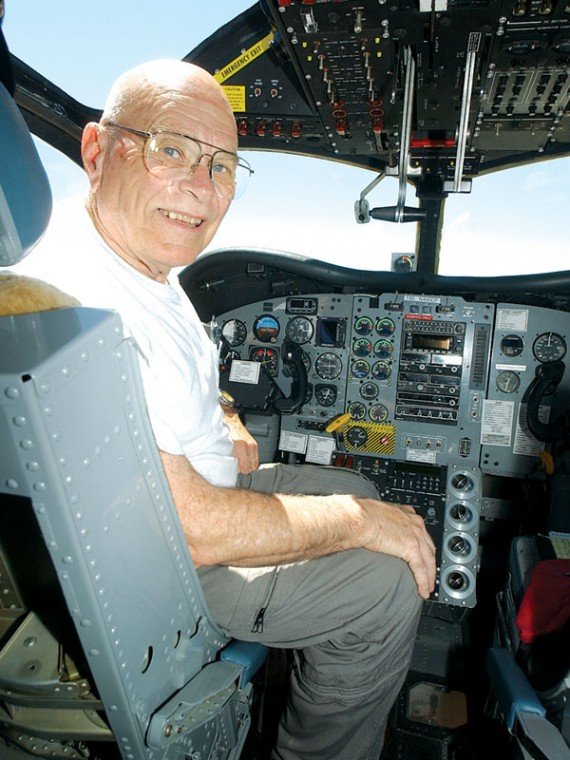For 35 years, he’s been putting out fires from his 30,000-pound,
258 mph CDF tanker
By Lori Stuenkel
Hollister – Airtanker pilot Vern Schindele paused while reading his newspaper and perked up to hear the dispatcher’s voice broadcast through the station.
Half a minute later, he sat in the cockpit of his Grumman Aerospace S-2T. In less than three minutes, he was on the runway, turbine engines roaring, awaiting the official call for air support.
Not bad for a 72-year-old who’s been a licensed pilot for more than half a century.
With 35 years on the job as an airtanker pilot with the California Department of Forestry, Schindele is enjoying his 21st season at the Hollister Air Attack Base.
Piloting during California’s fire season is a 6-day-a-week, 9-hour-a-day job, and Schindele must be ready to answer as many as seven calls in one day. A trip to Oakland to drop some of the 1,200-gallon load of fire retardant on a brush fire takes about 12 minutes. A trip to Morgan Hill or Gilroy, where Schindele helped fight the Croy Fire two years ago, is only a few minutes long.
Schindele enjoys flying his 30,000-pound, 258-mile-per-hour airtanker – No. 80 – because “it keeps (me) busy,” he said.
Although he calls Montana home for most of the year, he plans to keep coming back to Hollister from June through October.
“I don’t know, I’m starting to slow down,” he said recently, when asked of retirement plans.
A man of few words, Schindele’s expertise speaks for itself. He obtained his commercial pilot’s license, along with some friends, while a high school student in his native Southern California. He joined the United States Marine Corps and fought in the Korean War, where his plane “caught quite a few bullet holes.”
He was discharged from the Marines in 1957 and after several years as a corporate pilot, he flew a water scooper in Alaska and later Montana – where he fell in love with the area – for the Bureau of Land Management. In 1984, he joined CDF and dedicated himself to dispatch region 307, based in Hollister. The base, established in 1962, is one of the most sought-after in the state thanks to its high call volume and varying landscape, from forest to desert to the beach.
After returning to the base for two decades, Schindele earns high praise from his fellow air attack base crew.
“It’s amazing, because he’s like a legend. He’s the ‘Big Dog’,” said Capt. Jimmy Wilkins. “Imagine having someone in your office who’s been there 30 years.
“He entertains us, he has a big heart, he takes care of everybody,” he said.
According to Wilkins, Schindele has also trained his share of younger pilots through the years.
When he does decide to retire, Schindele will relinquish his plane’s parking space, labeled No. 1, to pilot No. 2, Russ Looney, who has been in Hollister for three years.
On a recent morning, Schindele returned his airtanker to the base after responding to a false alarm in Carmel Valley. He hopped out and topped off the fuel tank while another CDF crewmember re-filled his retardant supply. Pilots must dump 300 gallons of their load before landing, to meet the weight requirement.
Schindele dresses casually in a pair of thick khakis, work boots and a T-shirt, with his log book in the pocket. Once he’s done fueling, a streak of brown across the tarmac means Lizzie, his 2-year-old miniature dachshund, is coming to meet him.
“She’s kind of the base mascot,” Schindele said, scooping her up into his arms.
The Hollister Air Attack Base houses an air attack plane – used to track fires from the air and coordinate air support – and a second airtanker. The three planes cover from near King City to Tracy, and from the San Joaquin Valley to the Monterey Bay.
But the pilots can end up anywhere in the state, if support is needed. Schindele keeps a packed overnight bag in his plane because “you never know where you’re going to end up.”
This is Schindele’s second year flying his turbine-engine plane, which the CDF is using to replace the propellor-driven planes used since the 1970s. The S-2Ts are faster, safer, more maneuverable and carry twice as much fire retardant.
“It’s the difference between day and night,” Schindele said of the turbine engines. “These things are modern, high-tech. … They’re wonderful to fly, you can get into tight holes and you don’t have to worry about getting out of them.”
Schindele said he knows 40 pilots who have died on the job when their older S-2A planes crashed. That fact doesn’t worry him when he’s in the air, he said, but it does make him “a little more cautious.”
At the end of the fire season in October, Schindele will pack up the 35-foot trailer in a Hollister recreational vehicle park he calls home while in California, put Lizzie in his pick-up and take a road trip back to Montana. Once there, he’ll enjoy a reunion with his third wife Phyllis, who he married six years ago.
In the off-season, he sometimes pilots private charters or dusts crops. Lizzie likes to join him when he spends time outdoors, especially when he rides his snow-mobile.
For all he’s seen, home in Montana is Schindele’s cloud nine.
“It’s beautiful country out there,” he said. “I drive to Billings, it’s 130 miles by highway. If you meet 10 cars, it’s heavy traffic.”
New Gel Retardant Like Baby’s Diapers
Gilroy – A new product is changing the way firefighters battle brush fires, and crews at the nearby air support base for the California Department of Forestry are raving about it.
Still in the testing stages, the water-enhancing gel has replaced the traditional red chemical retardant dropped from airtankers stationed at the Hollister Air Attack Base over wildland fires in Santa Clara, San Benito, Monterey, and Santa Cruz counties.
Hollister is one of a handful CDF air bases using different vendors’ versions of the gel, but one product will be selected to be used statewide next year.
“I’m impressed with the stuff,” said Vern Schindele, who has been an airtanker pilot for 30 years. “It’s so much more efficient, it’s easy to clean off the airplanes … it’s more environmentally friendly.”
It actually extinguishes fires, whereas the old retardant merely slowed flames, he said.
The Hollister base is using FireOut Ice, developed by Richard Rawls of Virginia. Similar to the absorbent material inside baby diapers, the product starts as a powder similar in appearance and texture to laundry detergent.
When mixed with water, each of the dry particles absorbs hundreds of times its weight in water and holds it, creating a soft, beady gel.
“Basically, it’s a gazillion itty-bitty sponges,” said Scott Robinson, captain of operations with FireOut.
The gel then sticks to any substance, holding the water right where it’s needed. It can be dropped ahead of a fire to protect an area, or placed directly onto the flames to quash them.
The gel is so efficient, said Capt. Mark Edria, it is already changing the way CDF air attack handles fires. Traditionally, as a fire spread in a V-shaped pattern, firefighters battled it from the edges to work their way in and up toward the “head,” or the hottest, advancing edge of the fire. Airtankers would assist by dropping chemical retardant on the outside edges.
With the gel, airtankers now make drops directly on the head of the fire and stops its forward march.
“Once we drop the gel, it’s done,” Edria said. “With the retardant, it was a constant back-and-forth.”
To demonstrate, CDF Capt. Jimmy Wilkins spread the gel onto a piece of cardboard, held it vertically, and put a blow torch to it. The gel stayed in place and the cardboard appeared undamaged, even as Wilkins held the blow torch flame in one spot. When Wilkins edged the blow torch to the unprotected cardboard, it immediately blackened and caught fire.
The gel is colored blue with a non-toxic dye similar to food coloring, and both the gel and the coloring decompose naturally in the sunlight. It can be cleaned off surfaces with water.
Per gallon, FireOut weighs a couple ounces more than plain water, so pilots have no problem filling the airtankers’ 1,200-gallon tanks. The tanks can be re-filled in about three minutes from a holding tank located at the air base.
The water-enhancing gel is also cheaper per gallon than the chemical retardant, Capt. Wilkins said, although he did not have exact figures.













